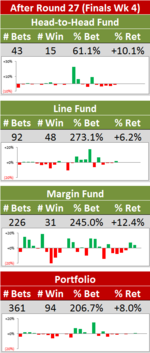Overround as Insurance
 Saturday, May 14, 2011 at 5:52PM
Saturday, May 14, 2011 at 5:52PM During my first moments of consciousness this morning a thought entered my head unbidden, that "overround is the bookie's means of hiding behind imperfect probability assessments".
Side-stepping any discussion of quite why my brain would have spent any part of the night pondering this topic - I blame the inordinate amount of time I've been spending running simulation of the bookie v punter contest over on the Simulations blog - it's actually an accurate statement.
First, a little algebra.
Let's define:
- P to be the true probability of victory for a team
- B to be the probability assessment of the bookie for that same
- V to be the overround embedded in the bookie's prices for that team
From these, we can determine:
- The bookie's price for the team will be 1/(B x V).
- The expected return to a punter wagering on the team will be P x (1/(B x V) - 1) - (1-P), which reduces to P/(BxV) - 1.
- This expectation is positive if P/(BxV) > 1 or, rearranging, if P/B > V or, equivalently B < P/V.
So, the larger is V, the bookie's overround, the larger can be the difference between the bookie's assessment of a team's chances and the team's true probability.
The following table might help to make this more concrete:
The entries show the minimum assessment of a team's chances that a bookie might (erroneously) make and then use to set a price without (unwittingly) creating a wager with a positive expectation for a savvy punter.
So, for example, consider the row relating to an overround of 107% and assume that we're looking at a game where a team's true probability of victory was 75%. In this case, a bookie working with this size overround as protection would be safe from creating a bet with a positive expectation provided that his assessment of the team's chances was no lower than 70%. In other words, his assessment can be out by as much as 5% points and he can still expect to make a profit. (Of course, since his price on the team we're considering will be too high if his estimate of their chances is less than their actual probability, his price on the other team will be too low, assuming that the overround in its price is not significantly lower, so there'll not be a positive expectation on offer there.)
As a very approximate rule of thumb, for near even-money teams the bookie can afford to be out by 1% point in his probability assessments for every 2% point increase in overround. For near-certainties his probability assessments can afford to be out by 1% point for every 1% point increase in overround.
 TonyC |
TonyC |  Post a Comment |
Post a Comment | 


Reader Comments